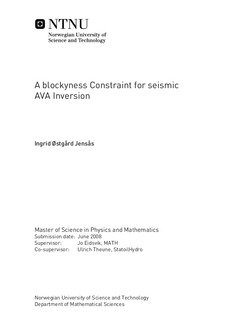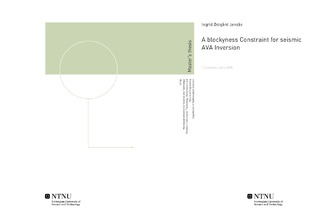| dc.description.abstract | The aim of seismic inversion is to determine the distribution of elastic parameters from recorded seismic reflection data. If a combination of elastic parameters is known, they indicate a certain fluid or lithology. Elastic parameters can therefore be very good hydrocarbon indicators. Although it is possible to interpret the reflection data from seismic acquisitions after processing, an improved analysis can be achieved by inverting for elastic properties. This can contribute to improved vertical resolution of the image. This work applies different applications of the blocky seismic inversion technique, which is based on Bayesian inversion. Generally, a Gaussian prior for the three elastic parameters P-wave velocity, S-wave velocity and density is assumed in inverse problems. This assumption does not always provide sharp edges between layers, and the idea of the work reported here is to improve this by assuming a prior distribution for the contrasts in the elastic parameters with more probability of high contrasts. Since the Cauchy distribution has heavier tails than the normal distribution, the idea for the blocky inversion is to assume a Cauchy prior distribution for the contrasts in the elastic parameters. Inversion is a non-unique process, hence, the more reasonable prior information we use, the better the result. When using statistical inversion based on Bayes' rule, the prior distribution is used to shape the solution, and the modified Cauchy norm can help provide a solution with better focused layer boundaries. The scale parameter in the Cauchy distribution is not very easy to estimate, and different methods are tested. Spatial coupling of the model parameters m is introduced along a line to provide lateral consistency and robust results from inverse problems. The 2D inversion was done by assuming a Markov model where the inversion result at one location depends only on the neighbouring traces. This implies a sparse structure of the matrix to be inverted, and Cholesky factorization was used as a computational tool. This method allows tracewise nesting in contrast to setting up the whole operation matrix for all traces at a line, and therefore reduces the computational time significantly. The aim of this approach was to consider the use of lateral correlation while inverting data as a sophisticated way of stacking data to improve the signal to noise ratio. To get a picture of the uncertainties in the inversion result, different methods, such as importance sampling was performed, even though the answers were unreasonable large. This remains a topic for further work. The data used in this work are a synthetic created case and real seismic data from the Kvitebjørn field in the North Sea. | nb_NO |

